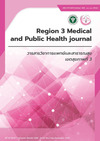A study of the intermediate- to long-term outcome of corrosive ingestion in Swanpracharak Hospital.
คำสำคัญ:
corrosive ingestion, high-grade esophageal injury, esophageal strictureบทคัดย่อ
Abstract
Background/Aims: The ingestion of corrosive substances is linked to enduring consequences, particularly in cases with high-grade mucosal damage. This study aimed to examine the correlation between the severity of mucosal injury grading and the intermediate (more than one-month follow-up) to long-term outcomes (more than 12 months) following corrosive ingestion.
Methods: Patients who presented with corrosive ingestion between January 2017 and December 2022 were included consecutively. A comprehensive review of medical records was conducted to gather information regarding the substance ingested, intent, symptoms, amount, injury grade at endoscopy, and clinical during follow-up.
Results: During the study period, a total of 106 patients were admitted with corrosive ingestion, out of which 72 underwent esophagogastroduodenoscopy (EGD). Among the patients who underwent EGD, 19 (26.4%) were found to have high-grade esophageal lesions. The severity of gastrointestinal mucosal injury was not found to be related to the volume of ingestion or time to EGD, but upper gastrointestinal hemorrhage was significantly associated with high-grade esophageal injury and mortality. Three patients died during the index hospitalization, and the remaining patients were followed up for a median period of 821 days (14-1295), during which 18 patients were lost to follow-up before one year. During the intermediate-term follow-up, three patients with high-grade injuries died as a result of corrosive ingestion (length of hospital stay 45, 325, and 350 days, respectively), and four patients had significant esophageal strictures. Neither group exhibited any adverse consequences of corrosive ingestion during the long-term follow-up.
Conclusions: Patients with high-grade esophageal mucosal lesions experienced significant morbidity and mortality during the intermediate-term follow-up. On the other hand, patients with low-grade esophageal injury did not exhibit any adverse consequences during the follow-up period. Therefore, after an endoscopy shows a low-grade esophageal mucosal lesion, patients can be treated as outpatients. The follow-up is not necessary after one year if the patients did not experience any adverse event.
Keywords: corrosive ingestion, high-grade esophageal injury, esophageal stricture
เอกสารอ้างอิง
References
Hall AH, Jacquemin D, Henny D, Mathieu L, Josset P, Meyer B. Corrosive substances ingestion: a review. Crit Rev Toxicol. 2019;49(8):637-69.
Lakshmi CP, Vijayahari R, Kate V, Ananthakrishnan N. A hospital-based epidemiological study of corrosive alimentary injuries with particular reference to the Indian experience. Natl Med J India. 2013;26(1):31-6.
Botwe BO, Anim-Sampong S, Sarkodie BD, Antwi WK, Obeng-Nkansah J, Ashong GG. Caustic soda ingestion in children under-5 years presenting for fluoroscopic examinations in an Academic Hospital in Ghana. BMC Res Notes. 2015;8:684.
Sabzevari A, Maamouri G, Kiani MA, Saeidi M, Kianifar H, Jafari SA, et al. Clinical and endoscopic findings of children hospitalized in Qa’em Hospital of Mashhad due to caustic ingestion (2011-2013). Electron Physician. 2017;9(4):4248-50.
Ducoudray R, Mariani A, Corte H, Kraemer A, Munoz-Bongrand N, Sarfati E, et al. The Damage Pattern to the Gastrointestinal Tract Depends on the Nature of the Ingested Caustic Agent. World J Surg. 2016;40(7):1638-44.
Chibishev A, Simonovska N, Shikole A. Post-corrosive injuries of upper gastrointestinal tract. Prilozi. 2010;31(1):297-316.
Millar AJ, Cox SG. Caustic injury of the oesophagus. Pediatr Surg Int. 2015;31(2):111-21.
Le Naoures P, Hamy A, Lerolle N, Metivier E, Lermite E, Venara A. Risk factors for symptomatic esophageal stricture after caustic ingestion-a retrospective cohort study. Dis Esophagus. 2017;30(6):1-6.
Cheng HT, Cheng CL, Lin CH, Tang JH, Chu YY, Liu NJ, et al. Caustic ingestion in adults: the role of endoscopic classification in predicting outcome. BMC Gastroenterol. 2008;8:31.
Chibishev A, Pereska Z, Simonovska N, Chibisheva V, Glasnovic M, Chitkushev LT. Conservative therapeutic approach to corrosive poisonings in adults. J Gastrointest Surg. 2013;17(6):1044-9.
Zargar SA, Kochhar R, Mehta S, Mehta SK. The role of fiberoptic endoscopy in the management of corrosive ingestion and modified endoscopic classification of burns. Gastrointest Endosc. 1991;37(2):165-9.
Kochhar R, Ashat M, Reddy YR, Dhaka N, Manrai M, Sinha SK, et al. Relook endoscopy predicts the development of esophageal and antropyloric stenosis better than immediate endoscopy in patients with caustic ingestion. Endoscopy. 2017;49(7):643-50.
Havanond C, Havanond P. Initial signs and symptoms as prognostic indicators of severe gastrointestinal tract injury due to corrosive ingestion. J Emerg Med. 2007;33(4):349-53.
Havanond C. Clinical features of corrosive ingestion. J Med Assoc Thai. 2003;86(10):918-24.
Cabral C, Chirica M, de Chaisemartin C, Gornet JM, Munoz-Bongrand N, Halimi B, et al. Caustic injuries of the upper digestive tract: a population observational study. Surg Endosc. 2012;26(1):214-21.
Zerbib P, Voisin B, Truant S, Saulnier F, Vinet A, Chambon JP, et al. The conservative management of severe caustic gastric injuries. Ann Surg. 2011;253(4):684-8.
Chibishev A, Pareska Z, Chibisheva V, Simonovska N. Clinical and epidemiological features of acute corrosive poisonings. Med Arch. 2012;66(3 Suppl 1):11-5.
Bharath Kumar C, Chowdhury SD, Ghatak SK, Sreekar D, Kurien RT, David D, et al. Immediate and long-term outcome of corrosive ingestion. Indian J Gastroenterol. 2019;38(4):356-61.
ดาวน์โหลด
เผยแพร่แล้ว
วิธีการอ้างอิง
ฉบับ
บท
การอนุญาต
ลิขสิทธิ์ (c) 2023 Region 3 Medical and Public Health Journal - วารสารวิชาการแพทย์และสาธารณสุข เขตสุขภาพที่ 3

This work is licensed under a Creative Commons Attribution-NonCommercial-NoDerivatives 4.0 International License.




